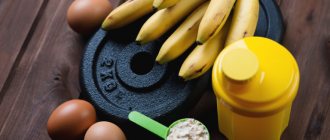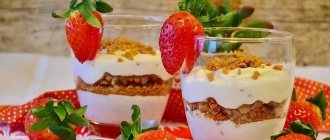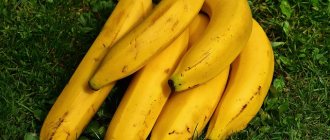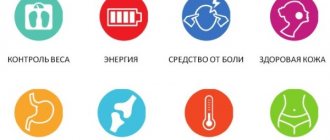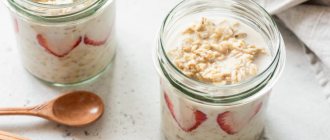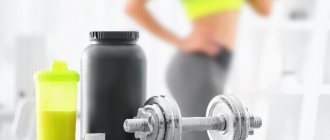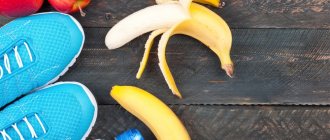- Drinking regimen during training
- Breakfast
You can go to the gym to maintain good health, lose weight or build muscle mass. But without a properly developed nutrition plan, it will not be possible to achieve positive results. And in order for training in the gym or at home to please you with changes in your figure, you need to know how to eat properly during training
.
What is honey made of?
The composition of honey is very complex - it contains over 300 substances, some of which have not yet been identified. Almost 80% of the product consists of carbohydrates:
- Glucose - up to 36%. Main energy supplier.
- Fructose - up to 33–42%. It is superior to other carbohydrates in sweetness and, under certain conditions, is converted into glucose.
- Disaccharides - from 5 to 10%, mainly presented in the form of sucrose (up to 6%) and maltose (4-6%). Their concentration in honey is determined by its type; most maltose is present in linden honey, and significantly less in sunflower honey.
- Dextrins. The result of the breakdown of starch as a result of interaction with bee enzymes. Slows down the crystallization of honey.
The proportion of water in the product varies from 15 to 21% and depends on maturity, type, climatic conditions, storage temperature.
Protein substances
Their concentration is 0.04–1.56%. Protein substances enter honey along with plant pollen or are formed as a result of exposure to bee saliva and are represented by the following enzymes:
- invertase - ensures the breakdown of sucrose into fructose and glucose;
- amylase - promotes the breakdown of starch;
- catalase is an enzyme through which oxidation and reduction processes occur.
Enzymes perform the function of biocatalysts, helping to accelerate and more actively occur the reaction.
Important! When heated, enzymes lose activity and the beneficial properties of honey disappear!
Amino acids
The special value of honey is that it contains an almost complete set of essential amino acids (valine, isoleucine, lysine and others), that is, those that the human body cannot produce on its own. These substances are needed for biochemical transformations; without them, protein synthesis, the main building material for muscles, will not occur.
Organic acids
The proportion of organic acids in the product can reach 0.1%. They have a significant impact on taste and smell. Fruit and lactic acids give honey a pleasant sourness, promote long-term storage, and enzyme activity lasts longer. The acidity of honey mainly depends on the place of collection.
Minerals
The mineral substances present in honey, and this is up to 0.02–0.8%, are enough to fully provide the body with vital elements and minerals. 100 g of product contains 4% of the daily value of zinc, which is not so often found in foods, and copper, about 7% of iron (promotes the formation of red blood cells), potassium and manganese, approximately 25% of cobalt. To fully saturate the body with minerals, it is enough to consume 1 tablespoon of honey every day.
Vitamins
Honey contains a complex of B vitamins, vitamin C, nicotinamide, retinol, tocopherol, vitamin K. It is noteworthy that they retain beneficial properties for several years. The concentration of vitamins depends on the properties of pollen.
Other substances
In addition to carbohydrates, minerals and vitamins, honey contains pollen, phytoncides - which provide the antibacterial effect of the product, aromatic and coloring substances, as well as hormones. The latter have a positive effect on the cardiovascular system. The product also contains fungal organisms and yeast, which cause fermentation.
Composition of honey
Honey is a substance consisting of fructose, the rest of it is glucose and disaccharides (sucrose and maltose). The composition of honey is always the same, regardless of what the honey is processed from, but the amount of maltose is different. For example, the most of it is in linden honey, and the least of it is in sunflower honey.
Honey also contains dextrins - these are bee enzymes that affect the rate of honey crystallization. It also contains vitamins, minerals and even amino acids, but their quantity in this product is extremely small to provide a person with the required amount of elements.
The benefits of honey for the body
The healing properties of honey have been known for a long time - it is recommended to use it not only for treatment, but also for the prevention of diseases and strengthening the immune system. Main beneficial properties:
- saturating the body with useful substances: vitamins, minerals, phytoncides;
- antioxidant effect, provided by acids and flavonoids - reduce the likelihood of cancer and cardiovascular diseases, diabetes;
- lowering blood pressure - it is enough to use honey instead of regular sugar, a side effect is a decrease in the level of cholesterol and triglycerides in the blood;
- pronounced antibacterial effect - honey is used to treat dermatological pathologies, including psoriasis;
- activation of metabolic processes, normalization of acidity in the stomach, correction of the microflora of the gastrointestinal tract;
- strengthening the immune system.
Honey is actively used to treat viruses and colds - alone or together with other natural products.
What are the beneficial properties of honey for athletes?
The beneficial properties of a bee product for athletes are based on its component composition. Honey includes an amino acid series that is necessary for muscle fibers. The presence of simple and complex carbohydrates, proteins, vitamins and microelements includes nectar in the group of mandatory products when playing sports. Benefit:
- absence of a sharp jump in blood glucose and reduced release of insulin compared to sugar;
- provision of ready reserves (glycogen) for energy output;
- strengthening immune defense, aiding recovery after exercise;
- the presence of a complex of amino acids in an easily digestible form, which goes towards building muscles;
- supply of simple carbohydrates for quick energy;
- stimulating progress in strength exercises;
- normalization of metabolism, saturation with vitamins and minerals;
- cleansing the body of free radicals, waste, toxins;
- calming the nervous system, which is required for restorative sleep;
- reducing “bad” cholesterol in the blood, the risk of hypertension, diabetes, heart disease, obesity;
- destructive effect on fungi, bacteria, elimination of inflammation.
Honey in sports is valued for improving appearance, athletic performance, and also for its overall benefits to the body. If you replace sugar with a bee product, you will experience weight loss.
Pre-workout honey
To maximize the effect of exercise, it is necessary to provide the body with a sufficient supply of energy, that is, you should consume carbohydrates. Honey is considered their best source for a number of reasons:
- fast digestibility - up to 60 minutes;
- increased activity and endurance - the athlete tolerates stress better;
- high concentration of carbohydrates - up to 80%, with a complete absence of fats;
- A sharp decrease in blood sugar, which can cause loss of consciousness, is excluded.
It is preferable to use an aqueous solution of honey, the optimal dose is 1 g per 1 kg of body weight. Experts recommend taking it 30–60 minutes before the start of your workout. As a result, the bodybuilder is able to exercise longer and more productively, and feels less fatigue.
Don't exercise on an empty stomach
First, let's figure out what and when to eat before training. We dismiss exercises on an empty stomach right away: we don’t have enough strength to finish exercising to the end. Hunger disrupts coordination of movements, breathing rhythm and exercise technique (hello, injuries!), Hungry fainting may even occur.
At the same time, if you are overweight, your task during fitness is to start the process of destroying the reserves of subcutaneous and internal fat. Once it gets from the depot into the blood, in any case, after 5-7 minutes of movement, it will begin to be utilized by the working muscles and heart. After 20 minutes of continuous movement, the body will already work mainly on fat. But how to force this stubborn substance to leave its homes?
Fat reserves are broken down as a result of a complex biochemical chain that involves hormones, neurotransmitters, etc. The trigger is physical exercise for at least 20 minutes straight. Accordingly, food before training should provide energy for these 20 minutes and for the production of neurotransmitters. At the same time, food should not interfere with exercise and, most importantly, not replenish the blood with fats! Otherwise, why would they leave the depot?
Based on this, simple rules for pre-workout nutrition have been formulated.
- Eat about 1.5-2 hours before fitness.
- Choose complex carbohydrates and some protein (proteins): buckwheat + meat, rice + chicken, low-fat cottage cheese. The portion should be small so as not to overfill the stomach.
- You can supplement it with vegetables, especially watery ones like cucumbers and tomatoes, but not too much. Otherwise, you will come to class and endlessly run to the toilet - an excess of vegetables can cause such provocations during fitness.
- You can eat fruits and berries , but only a little - too many fast carbohydrates from them will make the release of fat from the depot completely unnecessary, because the muscles will already have something to eat.
- No fats - they are especially common in mayonnaise-based (white) sauces. It’s better to make a sauce from vegetables and minced meat (Bolognese type); it can also be used as a protein component of a meal.
- The calorie content of a meal is 200−500 kcal (the longer and more intense the workout, the more).
Honey after sports training
Promotes active restoration of muscle cells after exercise; it is recommended to use it after exercise or in the evening, before bed (on the day of training). Benefits of honey for athletes:
- normalization of energy metabolism after physical activity;
- slowing down catabolism (the process of cell destruction);
- providing the body with the nutrients necessary for muscle growth;
- antioxidant effect, removal of breakdown products.
After strength exercises, it is recommended to combine honey with protein foods, in particular beef, chicken, cottage cheese, and egg whites. Tea with honey after a workout helps to quickly restore strength - keep in mind that nectar retains its beneficial properties at temperatures up to 40 ⁰C.
What are the benefits of natural honey for athletes?
Few people know that this is an excellent tool that helps build muscle mass faster, without harming the body.
This remedy will be especially useful for bodybuilders, since they are the ones who most often need to accelerate muscle growth. Honey will bring the following benefits to all trainees:
- The product helps burn excess fat reserves, which, in turn, accelerates and makes muscle building more effective;
- When performing basic exercises, strength indicators increase;
- The vitamins, micro- and macroelements contained in the composition increase the body’s protective functions and strengthen the immune system;
- Systematic consumption of this sweet helps to normalize metabolic processes;
- Honey is able to launch regenerative and restoration processes in the body;
- After hard and long training, the athlete’s energy resources are restored several times faster.
Honey during workout
It is recommended to drink honey water if the main goal of training is to gain weight. In this case, it is necessary to provide the body with fast carbohydrates to avoid the destruction of muscle cells. Trainers recommend consuming honey during the most active part of the workout - about 1–1.5 teaspoons. Honey should be dissolved in warm, but not hot water.
Also, honey during training will be useful for bodybuilders prone to hypotension (low blood pressure) - during the period of peak exercise they may experience dizziness and weakness, which can result in fainting. Thanks to “feeding”, you will be able to avoid such phenomena and train to the maximum of your physical capabilities.
The choice of therapeutic nutrition for cancer
As is known, the tumor actively uses nutrients supplied with food, as well as endogenous metabolic products. Therefore, for many years, nutritionists have tried to find a compromise solution, to choose a diet that would help the patient restore the balance of essential substances in the body, without at the same time stimulating the growth of atypical cells. To date, research has convincingly proven that malnutrition causes a more significant impact on the patient’s condition than on the tumor’s condition. Experts have come to the conclusion about the importance of nutritious, but gentle nutrition for cancer patients. The tumor process depletes the body, and therapeutic measures (chemo- and radiation therapy significantly) also contribute to this, which, as a rule, have a pronounced effect on the patient’s condition and his ability to regarding nutrition. Thus, the diet during courses of treatment should help the patient not only fight the disease, but also recover from aggressive procedures and reduce the severity of side effects.
Nutrition for gastrointestinal cancer, especially in ostomy patients, requires an even more careful approach. Disruption of the digestive system leads to a pronounced deficiency of essential vitamins and microelements, exacerbating the problems caused by the oncological process.
Effective dietary correction cannot always be achieved by prescribing an oral diet with regular food. To support patients in oncology, special products have been developed in the form of nutritional mixtures based on large amounts of protein, a balanced composition of carbohydrates and fats, which also contain vitamins and minerals. Such nutrition is more effectively absorbed by the body, complements or can replace meals when necessary.
With significant weight loss or tumors of the upper gastrointestinal tract, enteral nutrition is required: through a tube or gastro- or jejunostomy. This significantly expands the patient's recovery options.
The diet of an oncology patient should be balanced, rich in protein, vitamins and microelements. The criteria for properly selected nutrition are:
- maintaining body weight;
- stimulation of the immune system and regeneration processes;
- maintaining normal metabolism;
- reducing the load on the intestines and its adequate functioning;
- improvement of the patient's general condition.
All of the above requirements are met by products from Nestle:
- Peptamen®;
- Impact® Oral;
- Resource ®2.0 + Fiber;
- Resource®Diabet Plus;
- Resource®Optimum.
Each of them has its own specifics, their appointment is carried out according to indications, at the discretion of the specialist.
Peptamen®
The unique composition of Peptamen® is intended for patients with a sharply reduced ability to absorb nutrition due to problems of the gastrointestinal tract.
Nausea, vomiting, severe diarrhea, and inflammation in the intestines often accompany treatment in oncology, exhausting patients, weakening their strength and significantly depressing their well-being. In such cases, nutrition with a guarantee of absorption is required. Peptamen is such a food.
It is based on whey protein, hydrolyzed enzymatically into small peptides. Small peptides are absorbed even with a deficiency of pancreatic enzymes and impaired intestinal functions. Up to 70% of the fat component is made up of medium chain triglycerides, which are also fully absorbed and serve as a quick source of energy for the body.
Peptamen is available in two forms: as a dry mixture for preparing a drink and as a specialized tube feeding (ready-to-use product in special 500 ml containers - Peptamen® Enteral, Peptamen® AF). The dry mixture is adapted to taste for oral use, but can also be used for feeding through a tube or stoma. Specialized probe forms differ in the amount of protein (Peptamen® Enteral – 4 g/100 ml of mixture, Peptamen® AF – 9 g/100 ml of mixture) and are used for insertion into a stoma or probe.
The mixture is well tolerated even by very weakened patients due to the good digestibility of hydrolyzed 100% whey protein. An additional advantage is its rapid passage from the stomach, which reduces the risk of reflux. Low osmolarity and the presence of a full spectrum of vital minerals and vitamins make it possible to prescribe Peptamen as an additive to the main diet or as the only product for cancer patients with gastrointestinal problems.
Resource®2.0 + Fiber
A complete and tasty product from Nestle in 200 ml bottles, which contains a large amount of protein and calories to restore strength, essential vitamins and minerals, as well as dietary fiber necessary for normal intestinal function. It is intended to compensate for malnutrition, prevent weight loss before and after antitumor treatment, and can be used as the only or additional nutrition. The mixture normalizes intestinal function, helps speed up recovery after surgery, and improves the tolerability and effectiveness of therapy.
200 mg of Resource ®2.0 + Fiber contains 18 g of high-quality protein, 400 kilocalories of energy, 5 g of dietary fiber, all essential minerals, B vitamins, vitamins C, D, E, K, A, biotin, pantothenic acid, etc. High The calorie content and good digestibility of the product help maintain the body's strength during aggressive treatment and restore well-being and physical fitness after operations. Suitable for diet replacement and tube feeding. The natural composition allows the mixture to be used for a long time, if necessary. Can be used in patients with diabetes.
Resource®DiabetPlus
Resource®Diabet Plus is also a high protein product (18 g of complete milk protein per 200 ml drink). The composition is designed to meet the nutritional needs of people with diabetes or impaired glucose tolerance. The carbohydrate component is 90% represented by slow carbohydrates and isomaltose. Prebio1+ prebiotic fibers in combination with PHGG fibers (partially hydrolyzed guar gum) improve the condition of the intestinal wall, help normalize the gastrointestinal tract and have a beneficial effect on the glycemic profile. One bottle of drink replaces a full meal.
The product can be used either orally or through a tube, as a supplement to the diet, or as a complete replacement. Introduction of Resource®Diabet Plus into the diet for malignant neoplasms combined with impaired glucose tolerance or diabetes mellitus.
Resource®Optimum
A universal product is prescribed to prevent or correct loss of muscle mass before and after surgery, during long-term conservative treatment, palliative therapy, and simply to strengthen and maintain physical strength and normal well-being.
For active regeneration, the body requires a large amount of protein, and the Resource Optimum mixture completely covers its needs. 50% casein and 50% whey protein provide the full complement of amino acids needed to build cellular structures. Prebiotic dietary fiber improves the condition of the digestive tract and absorption processes. Live probiotics Lactobacillus Paracasei stimulate the immune system.
The dosage of Resource®Optimum, as well as Peptamen®, can be changed by dissolving the required amount of the mixture in water, depending on the nutritional needs and condition of the patient. If necessary, the product can become the only component of the daily diet.
Which type of honey is better to choose?
Preferably varieties with a high protein content are predominantly dark. In terms of its composition and properties, buckwheat honey, which has a characteristic dark brown color, stands out among them. It has a rich, bright aroma, and after drinking in its pure form it often causes a sore throat.
Buckwheat honey contains significantly more protein and iron (it is this that can give the product its characteristic reddish tint). Flower nectar collected from chestnut trees or meadow nectar has similar properties.
How does honey affect muscle gain?
After consuming honey, glucose is released gradually during exercise. Due to this, it is possible to significantly reduce the consumption of glucogen during exercise, and as a result, the body feels less fatigue. The athlete is able to train longer with maximum loads.
If you supplement your body with a portion of honey during the most difficult exercises, your muscle power will increase, which means you will be able to exercise to the limit of your capabilities. Thus, it is possible to achieve a better result. Drinking flower nectar after an intense workout partially neutralizes catecholamine, glucogen and cortisol - these hormones are produced more intensely than usual during times of exercise. Another reason for honey after training is closing the carbohydrate window. This effect is especially pronounced when the product is combined with proteins (meat, cottage cheese, egg whites).
Regular consumption of honey before, after and during physical activity helps to gain muscle mass. Including due to the active restoration of cells, the regular supply of nutrients necessary for their full development. Another plus is that the protective properties of muscle cells increase.
If you have an individual intolerance or allergy, you should avoid consuming honey.
Alcohol
Regular consumption of alcoholic beverages has a destructive effect on the body: immunity decreases, and the body’s ability to resist infections deteriorates. Alcohol disrupts the normal blood supply to the pelvic organs, leads to congestion, and worsens the metabolism of the prostate gland.
Many patients are interested in the possibility of drinking light alcohol, in particular beer. It is also not recommended to drink it constantly and during treatment. Such drinks contribute to changes in hormonal balance and reduce testosterone production. This negatively affects the health of the male gland.
Antibacterial therapy is another answer to the question of why you can’t drink if you have prostatitis. Infectious lesions are the basis for prescribing antibiotics. Almost all drugs in this group are incompatible with alcohol and cause severe adverse reactions that can pose a threat not only to the health, but also to the life of the patient. Excluding alcoholic beverages from the diet is an important factor for success in the treatment of prostatitis.
Is it possible to eat honey when dried?
The main goal of drying the body is to get rid of subcutaneous fat, which improves muscle definition and makes the body look more toned and slender. A similar result in bodybuilding is achieved as a result of hard training and special, carbohydrate-free nutrition with accurate calorie counting.
The carbohydrate content in natural honey can reach 80%. Thus, this product is contraindicated during the drying period, so if the desire to taste something sweet has become simply unbearable, it is better to use aspartame, saccharin and other sugar substitutes.
Is it possible to dry honey?
When drying the body (reducing body fat), a gradual reduction in carbohydrates in the diet is required. Changes in diet and training will allow muscle definition to appear. Athletes are interested in two questions:
- Can bee products be dried?
- Is it true that honey, when added regularly to the diet, burns fat.
There is no reliable answer to these questions. Flower nectars contain a high content of simple carbohydrates and calories, which is undesirable for drying. However, the bee product definitely provides more benefits than sugar, so it is sometimes used as a replacement.
Knowing what happens to the body when it dries will help determine how the bee product works. Flower nectar activates metabolism and stimulates the release of bile secretion, which is involved in the breakdown of adipose tissue. It is these processes that underlie drying. Vitamins and minerals are used to compensate for nutrients, the amount of which decreases with limited nutrition. Therefore, natural sweetness can not be removed from the diet.
If you decide to leave nectar in your diet, it is better to eat it in the morning on an empty stomach or for breakfast. It is common to take honey water (1 spoon of sweetness per glass). However, you can add honey to your morning meals. In the last weeks of drying, sweet foods are removed completely, as the amount of carbohydrates is minimized.
TOP 5 recipes with honey
- Honey with milk and banana. Heat 300 ml of milk to a temperature of 38–42 ⁰C, add 1 tablespoon of flower nectar, banana pieces. Beat with a blender until smooth. Use after physical activity.
- Honey with nuts and kefir. Ingredients: raw chicken egg, 1 tablespoon each of honey and walnuts, 200 ml of kefir. Mix all products and beat with a mixer. The cocktail is intended for use after training.
- Honey (50 g) with nut mix (30 g). Nuts can be any: almonds, walnuts, cashews, hazelnuts. Grind the ingredients and mix with 1 glass of orange or grapefruit juice. A great drink after a cardio workout. Drink at least 30 minutes before meals.
- Mix a clove of chopped garlic with 1 tablespoon of honey. Use the resulting mass before bedtime. Stimulates the synthesis of growth hormones and testosterone.
- Curd cocktail with honey. 100 g of cottage cheese, finely chopped banana, 1 tablespoon of honey and oatmeal, pour 1 glass of milk, beat into a homogeneous mass. Drink 60 minutes before training.
How to eat before a workout to lose weight
To lose weight, you need to properly organize your diet. You should not fast, especially before training. The body must have enough strength to work in the gym or when doing exercises at home.
Meals before training are organized taking into account several rules:
- Food should be light, mostly carbohydrates. Porridge is ideal for this.
- The last meal should take place 2 hours before training.
- You are allowed to drink kefir or eat an apple 30 minutes before.
To start the fat burning process, it is recommended to drink a cup of coffee before training. The drink will give you a boost of energy and help jump-start your metabolism.
What is suitable as a pre-workout meal for weight loss:
- porridge with water or milk;
- fruit and vegetable salads;
- breads.
Be sure to count calories - they should not be more than 200 for women and 300 for men.
Before training, take special supplements - thermogenic fat burners. Their action is aimed at increasing body temperature, thereby triggering fat burning mechanisms. What supplements can you buy:
- Nutrex Lipo-6 Black Ultra Concentrate. The active substance is caffeine. This thermogenic helps burn fat, increases endurance and improves mental focus.
- Nutrex Lipo-6X. The basis of this supplement is a unique multi-stage technology, thanks to which the substances are delivered gradually. This leads to rapid weight loss, increased physical strength and endurance.
- Olimp Thermo Speed Extreme. Suitable for those who want to lose weight and gain muscle mass. The supplement acts in several directions, helping the body withstand heavy loads.
Weight loss supplements are not a mandatory part of losing weight. But with them, the fat burning process will go much faster.
Return to article content
Post-workout nutrition to burn fat
After training, you should not eat carbohydrates. This is due to the fact that during physical activity and within 2 hours after it, the body launches an active fat burning mechanism, which is necessary to replenish lost energy. If you eat any carbohydrate product, the production of glycogen will begin thanks to carbohydrates, and not fat reserves.
After classes you need proteins. They help muscles work, maintain the beauty and tone of muscles. Thanks to protein foods, you can lose weight and gain a sculpted figure.
What can you eat after training:
- low-fat cottage cheese without additives;
- lean beef;
- chicken breast;
- egg whites;
- rabbit meat;
- lean fish.
You can always have a protein bar on hand that will satisfy your hunger and help overcome fatigue. For example:
- Power System Big Block 50%. A high-quality protein bar containing 50 g. squirrel. Ideal for a snack.
- VP Laboratory 40% High Protein. The composition contains 40 g. protein and only 18 grams. carbohydrates. Great for people who are losing weight.
- 32 Protein from Ironman. 32% consists of protein. It tastes good.
Special attention is paid to nutrition after training. It is important not to overeat and not exceed the calorie limit. It is important to remember the rules of fractional meals - often and in small portions.
Return to article content
Harm and contraindications
The bee product has many beneficial properties, however, in some cases it can be harmful. Contraindications:
- allergies and individual intolerances;
- some kidney diseases - you should consult a doctor;
- gastritis in a state of exacerbation;
- acute pancreatitis;
- asthma.
Women should use honey with caution during pregnancy. The daily intake should always be taken into account, as exceeding it can cause serious health problems.
Harm and danger of honey sweetness
Unfortunately, not everything is as rosy with this product as we would like to believe. The fact is that honey can bring not only benefits to the athlete’s body, but also cause harm.
Sweetness can:
- Cause an exacerbation of chronic forms of gastrointestinal diseases (for example, gastritis, ulcers, pancreatitis);
- If you have increased stomach acidity and frequent heartburn, honey should not be consumed;
- For diabetes of any type, it is better to abstain from honey;
- If you have pathologies of the kidneys and genitourinary tract, you should not drink large amounts of honey water. If the recommended doses of such a drink are exceeded (more than 2 liters), water poisoning may occur;
- Individual intolerance to the product can lead to vomiting, stomach pain, nausea, and stool disorders;
- If you are predisposed to allergic reactions of various etiologies, consuming honey nectar is prohibited.
Popular myths about honey
Recently, on the Internet and in print media you can find information about honey that is not true. We decided to debunk the 10 most common myths:
- Honey is an analogue of sugar. In fact, the difference is huge. The only similarity is the nutritional value. Honey has a set of beneficial vitamins and minerals, antibacterial properties, and improves immunity—sugar does not have such properties.
- Natural honey crystallizes within 4-6 months. The rate of hardening depends on the composition: the more fructose, the longer the product remains liquid.
- Honey from an apiary is inferior in healing properties to that obtained by wild bees. In fact, there is only one type of bee that collects nectar: honey bees. The properties of the product are determined solely by climate, plants and storage conditions.
- Dark honey is better than light honey. It has a slightly different composition, containing more protein and iron, which is why it is recommended for anemia, but in general, both the dark product and the light one have similar properties.
- Honey is medicine. It is used for medicinal purposes, but in fact it is a food product that can and should be used as a preventive measure or as an addition to the main therapy.
- When honey is heated, it becomes poisonous as toxic substances are formed. This is not true, since it initially does not contain elements that could harm human health. One thing is certain - under the influence of high temperatures, the beneficial properties are irretrievably lost.
- Honey should not be stored in transparent containers. It is not true. The main thing is the temperature regime and that the material from which the container is made does not interact with the product. Suitable glass, food grade plastic.
Conclusions: buy real honey, observe storage conditions and do not allow it to be heated to temperatures above 40 ⁰C, and then it will definitely retain its beneficial properties, taste and aroma.
The best time to drink honey nectar
In fact, opinions differ here. Some experts say that it is best to take honey or products with honey before starting a workout. Some believe that it is best to eat sweets after all the exercise. It is best to choose a middle ground.
Before training starts
Before heading to the gym or training ground (about an hour before the start of classes), eat some nectar (at the rate of 1 gram of sweetness per kilogram of body weight). To avoid choking on a sugary product, dilute it in a cup of warm water. This method, by the way, will help the product be absorbed by the body faster.
Consuming honey before sports activities will help improve your endurance performance. The product will charge you with energy and make your workout even more effective. Some athletes advise consuming nectar in combination with bee pollen . This option is even more useful and effective. To speed up muscle gain, add walnuts to honey . Nectar contains only light carbohydrates (for example, fructose, glucose, maltose, etc.), amino acids, vitamins and minerals. The product does not contain fat, and per 100 g of product there are approximately 65-80 g of carbohydrates. The sweetness is very nutritious and helps prevent hypoglycemia in an athlete.
After classes
After you finish all your sports activities (about 40 minutes after) eat some honey nectar again (the dose is calculated in the same way as in the previous paragraph). Sweetness will help reduce catabolic processes after intense physical exercise to almost zero, as well as restore the process of energy exchange. The amino acids from the composition will help the muscles relax slightly and recover after hard work. Flavonoids will remove metabolic and breakdown products, as well as toxins and wastes from the body.
You can also drink a little milk with honey before going to bed. This drink will help your body relax, calm your thoughts and give you a sound, peaceful sleep.
But you need to understand that you need to consume sweets wisely. Don't go overboard in this matter. The amount of honey nectar in the diet will depend on the nutritional program of each athlete. Typically, the maximum daily dose should not exceed 250 grams of sweetness.
How to distinguish natural honey from fake
Today there are a lot of counterfeit products on the market, usually at a slightly lower price. We offer several simple options for testing honey:
- Viscosity.
The natural product is viscous, heat it to 20 ⁰C, immerse a spoon in it, then lift it and slowly rotate - the mass will stretch and wrap around it. - Wateriness.
Check with a small piece of newspaper - drop a little honey, if it doesn’t spread, it means it’s natural. Got a wet mark? This is a fake. You can also check the presence of water using a small piece of bread - dipped in natural honey it usually hardens, but in low-quality honey it softens. - Presence of impurities.
Tested with iodine. Dilute honey with a small amount of water, then add a little iodine. Blue color indicates starch or flour content. - Presence of chalk.
Add a little vinegar essence to the honey solution. If chalk is present, characteristic foam will appear, its appearance will be accompanied by hissing. - Solid impurities.
Dissolve honey in warm water; the appearance of a solid sediment is one of the signs of a low-quality product.
Be sure to pay attention to organoleptic indicators. Real honey has a pleasant taste and fragrant aroma.
